
48 Calf Pasture Beach Road
Norwalk, CT, US, 06855
Tel:(203) 353-0373
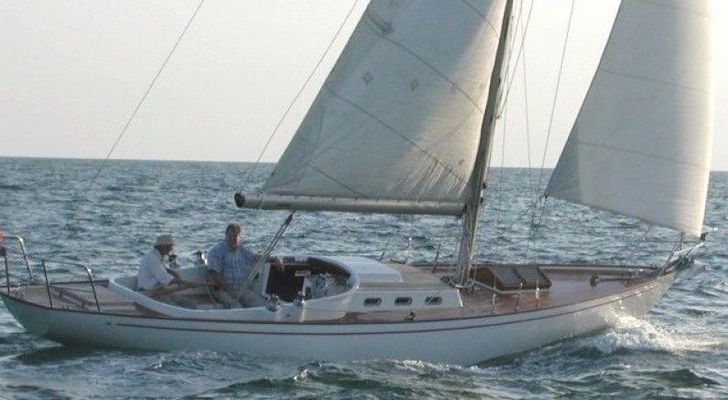
2005 D36 Celebrity Yachts
The term daysailer is used often these days in the boating community. When the owner of this D36 was looking for a daysailer we found that most were either too small and wet for sailing on those early Spring days, or candidly they were entirely overpriced for a boat that would truly be used for day use only!
An issue with many of the boats we looked at was that although the deck layout etc. were designed for single handling, the interiors often suffered. Not so with this boat. Down below she fitted out with varnished cherry wood, has plenty of headroom and is light and well ventilated by ample portholes and a huge hatch forward. She comes with a V-berth cabin forward with one head which is accessable via both the cabin forward and the saloon aft. The saloon has bench seating port and starboard which offer additional berths as well being fitted with a foldout settee for meal time. The aft-galley galley to port is adequately fitted for overnights with a 2 burner stove, stainless steel sink and generous stowage. There is a nav station to starboard.Although we call her a daysailer, maybe we really should call her an overnighter or weekender!
After purchasing the boat she went to a RI boat builder and the following improvements were made:
Main traveler installed aft of the cockpit, with adjustment lines run outboard to mid-cockpit
Jib traveler installed just forward of the boom
Shower installed in head
Shower installed in cockpit
Installed improved gray-water pumping system
Newly designed and built foredeck hatch
Single-line reefing of mainsail from the cockpit
Full cockpit cushions
Raymarine A65 Dual Display GPS/chart plotter
Dutchman mainsail flaking system
Boom cover modified for Dutchman lines
Canvas boat cover for winter storage
If you are thinking of classic lines, good sailing, and tons of upgrades, come have a look. Stored on the hard under a custom cover for the winter.
Specifications
Engine 1 Specifications
Media Gallery
 |
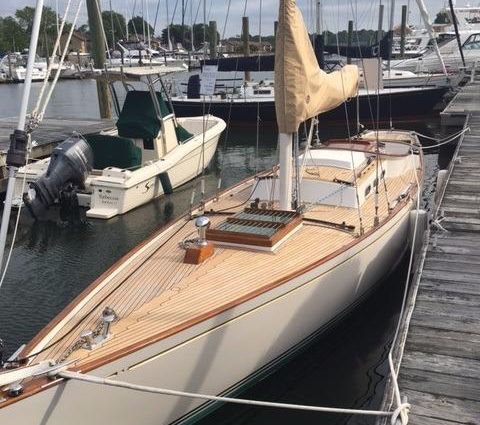 |
 |
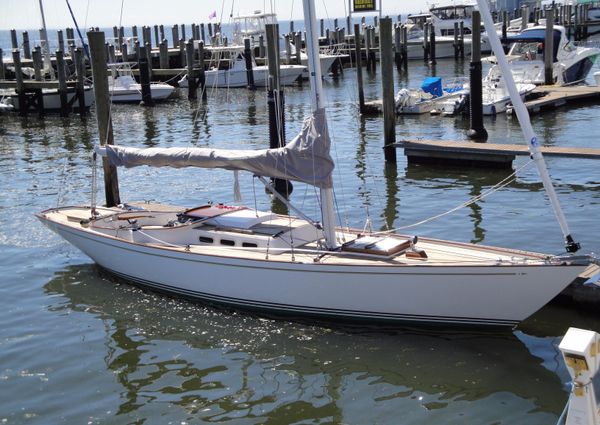 |
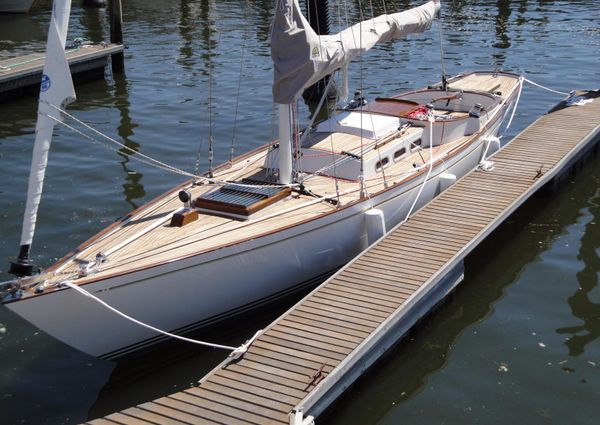 |
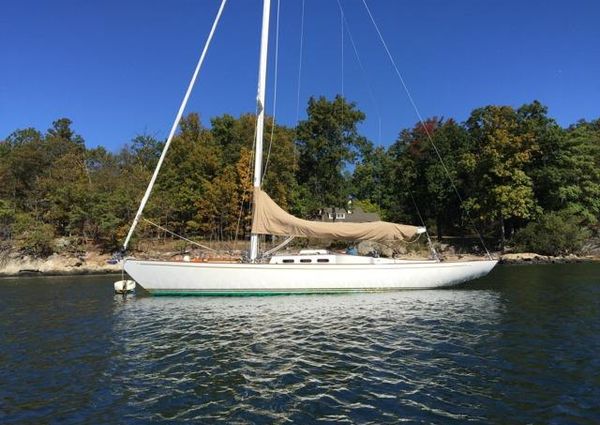 |
 |
 |
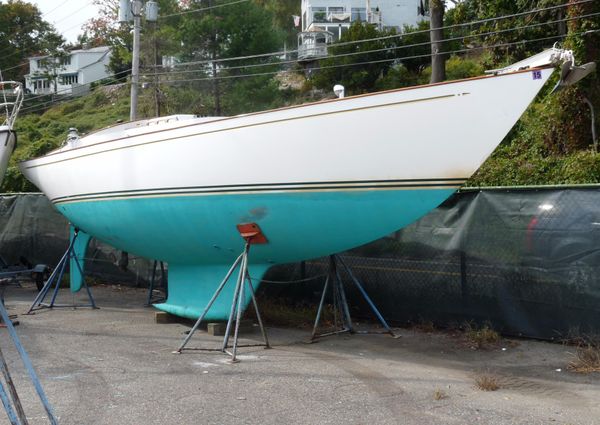 |
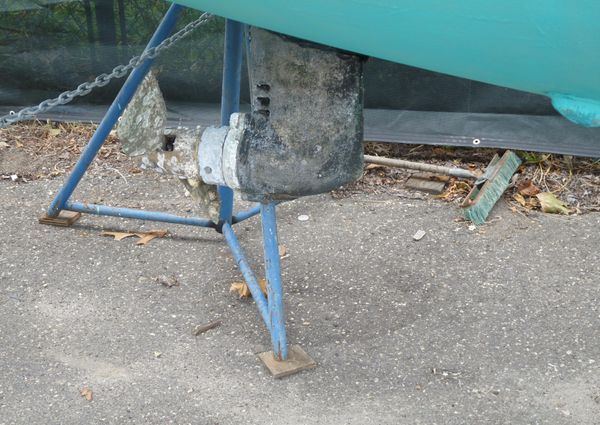 |
 |
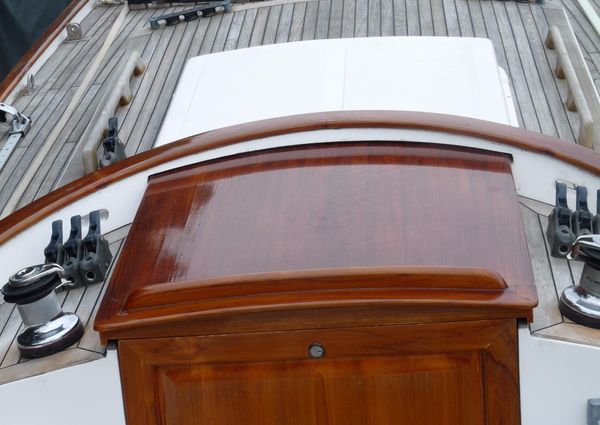 |
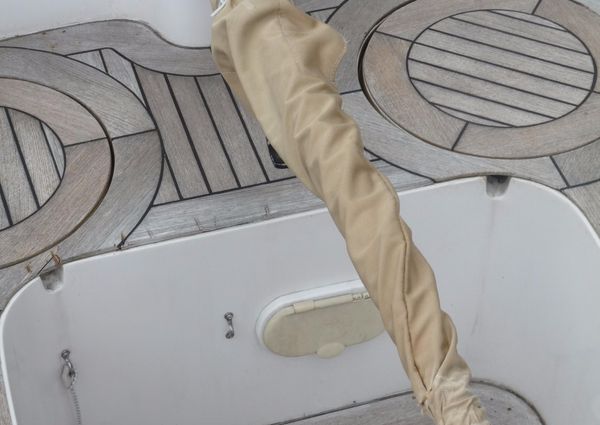 |
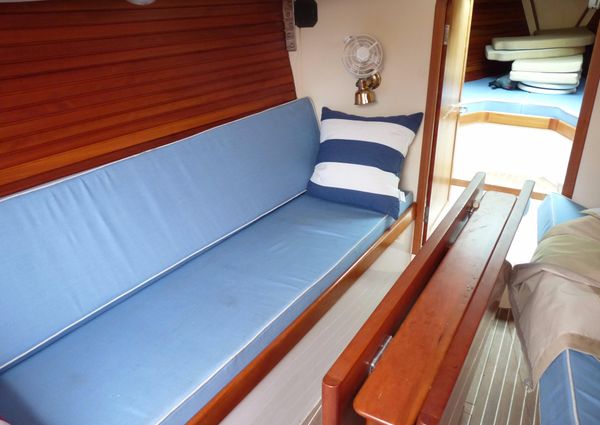 |
 |
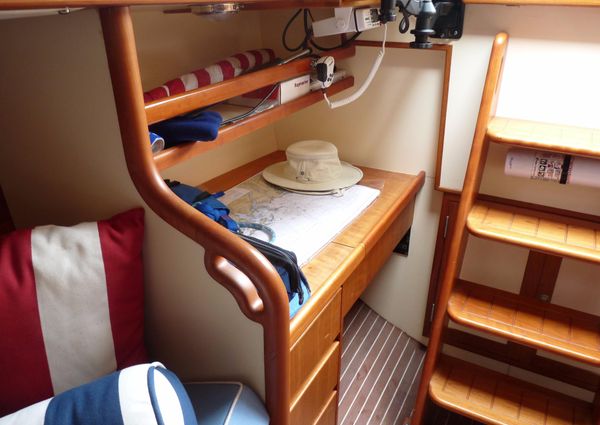 |
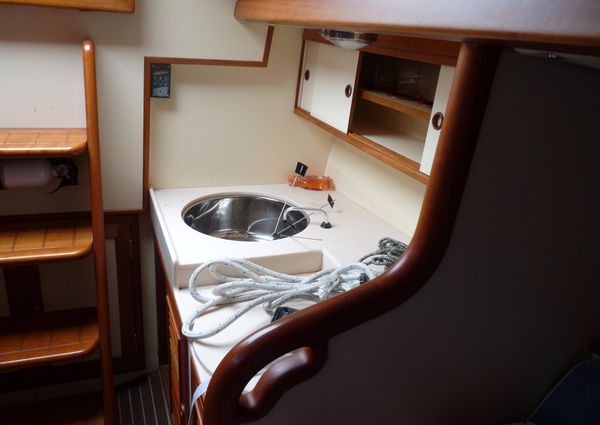 |
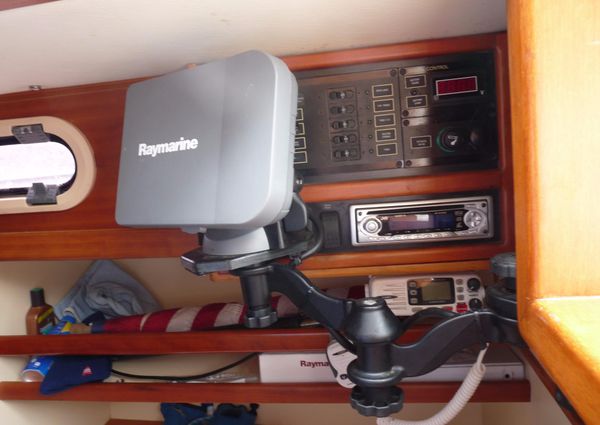 |
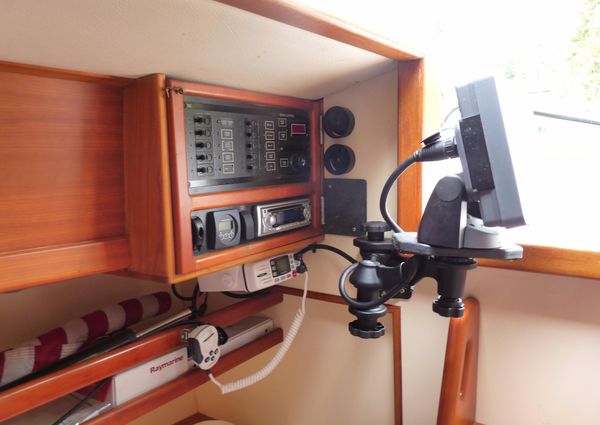 |
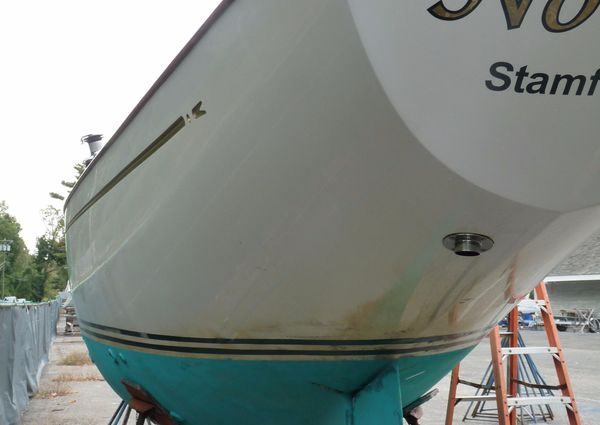 |
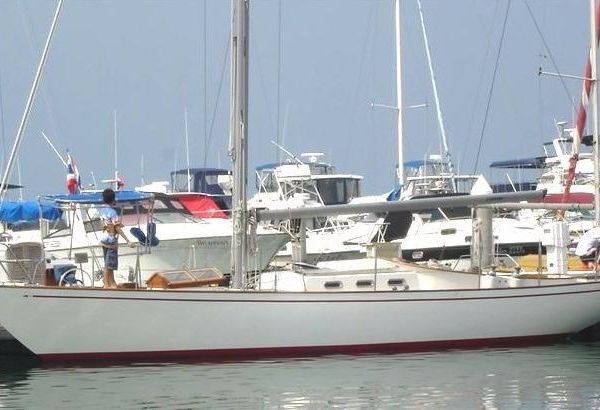 |
The interior is a satin cherry finish which looks exquisite. The overall Herrschoff classic interior with white bulkheads in contrast to the cherry is pure tradition.
As you go down the companionway the navstation is to starboard and has a very nice chart table and solid wood drawers. To port is a compact galley consisting of a large stainless sink with cupboards above the countertop.
Two very large settee berths are amidships with a beautiful folding cherry table. Both berths are just right for an afternoon read or to stretch out for a comfortable nap.
Just forward of the main salon is an enclosed marine head to starboard with spacious storage opposite to port. A custom butterfly hatch is directly above the head providing incredible ventilation and natural lighting.
Forward of the head is a V berth for storage or a restful night's sleep.
Raymarine depth, speed and wind are located in the cockpit to the forward starboard. A VHF is installed just forward of the companionway at the nav. station and within easy reach of the cockpit. An AM/FM CD radiion is also installed at the nav station.
An instrument panel for all DC electronics combined with an AC plug in for battery charging is standard.
The deck comes with teak side decks and a teak cockpit as standard.
Aft of the cockpit is a spacious aft storage locker and room for seating on the stern rail.
The cockpit itself is spacious and all winches are within reach of the helmsman. The mainsail sheet are located directly in the center of the cockpit making easy trim for any crewmember. At the aft of the cockpit seats are two very nicely configured, insulated beverage coolers set below the seats. These are very convenient and well nicely done.
All control lines for the rig lead aft to winches and line stoppers.
The rig is a fractional rig with an easy to handle 120% jib and large main. She sails wells under main alone, but really powers up with the headsail. She is a surprisingly dry boat even when beating to weather in 25 knots of wind.
Forward of the mast is the butterfly hatch and a dorade vent.
A varnished teak toe rail compliments the teak decks and adds a nice touch to the overall classic and traditional deck design. Hull & deck laminate to full Lloyds and ABS designs. GRP hand lay up with Lloyds & ABS Approved materials Teak-inlaid cockpit seats. Teak deck with UV resistant Sikaflex caulking . Bronze through-hull fittings with gate valves. Hull and deck joint bonded with glass fibre Teak Capping rail on raised bullwark SS stem head fittings Six (6) polished SS trim port-lights Sail locker aft lazerette. Removable Lead Keel ballast keel with stainless steel bolts Removable high aspect rudder with cast bronze shoe Classic hand made teak skylight on foredeck One teak dorade vent boxes with stainless steel cowls
- North 90% jib (fully battened)
- Doyle Mainsail
- Sail Area: 592 sq ft
- Fiberglass Hull
- Teak over cored balsa deck
- Mast 42' aluminum deck stepped
- Fractional Rig Sloop
- Designer: Andy Pitt ( Design based on classic 8 meter sloop)
To quote one of America's best yacht designers when discussing the Six-metre designs, Olin Stephens stated, "In any design the most important factors of speed seem to be long sailing lines, large sail area, moderate displacement and a small wetted surface. Then comes beauty which is meant as clean, fair and pleasing lines. The easiest boats to look at seem the easiest to drive."
The D36 meets the qualifications of easy to look at and easy to drive.
Upgrades:
Main traveler installed aft of the cockpit, with adjustment lines run outboard to mid-cockpit
Jib traveler installed just forward of the boom
Shower installed in head
Shower installed in cockpit
Installed improved gray-water pumping system
Newly designed and built foredeck hatch
Single-line reefing of mainsail from the cockpit
Full cockpit cushions
Raymarine A65 Dual Display GPS/chart plotter
Dutchman mainsail flaking system
Boom cover modified for Dutchman lines
Canvas boat cover for winter storage
Andy Pitt
Published by \'Sail\' - USA
Having built and sailed yachts for more than thirty years the opportunity to design and build my own boat came as an unexpected surprise. I’d thought about it for years but money and the situation were never quite right. Home builds can start well funded and euphoric but after a year or two many projects fail due to other commitments. The end, and the funding, should always be in place and in sight. To also design and build you own boat seems even more risky but suddenly the time was right and after the initial drawings I was hooked.\\r\\n\\r\\nThe classic ‘eight meter’ yachts are considered by many boat people as the most beautiful of all yachts. They represent a period of yacht design, building, and sailing from a time far different from today. William Fife, Charles Nicholson, Morgan Giles, Johan Anker, Alfred Mylne, and Henry Rasmussen, are but a few of the great designers synonymous with successful eight meter racing yachts. The real heyday of these yachts was from 1906 to 1936 but the class is still active today. They all had a narrow beam and long thin ends. ‘Connewago’ a typical example was 48’ 8” (14.86 m) overall with a beam of just 7’ 11” (2.41 m). In the summer of 1935 there were fifteen eight meter’s on the start line at Cowes. At least seven of these original yachts are still sailing today seventy years later, a tribute to the design and construction of these lovely boats. Eight meter yachts are not \\\\\\\'one designs\\\\\\\' and of course not eight meters long. The boats were subject to a complicated rating rule started after hefty international debate in 1906. This was later changed in 1919. Eight meters sailed in all the Olympic Games from 1908 to 1936. Classic ‘eights’ were built of wood, most commonly mahogany on oak frames but steel angle frames were occasionally used a method referred to as ‘composite’ construction.\\r\\n\\r\\nLovely and desirable as they are, forty five to forty eight feet is too big for me and most boat people agree a wooden yacht demands a great deal of time money and patience. They are not for the feint hearted but are incredibly desirable.\\r\\n\\r\\nDesign Criteria 2003:I wanted a classic sailboat with good looks and feel like an ‘eight meter’ but more ‘owner friendly’. The boat would not be based on, or for, racing. It had to have ‘low maintenance and running costs’ but not at the expense of loosing the ‘classic look’. It would be a boat which could be sailed alone but comfortable for two or three. It would also have a snug cabin with full standing height, toilet and galley, low tech gear and a modern underwater shape. She would have moderate draft and be well balanced on the helm. She also had to fit inside a standard ships container with mast, rig, and all our gear. This might seem a bit odd but I work as boat builder in Asia, sometimes in Europe and Scandinavia so need to send my boat where I’m living, at a reasonable cost. I also want to sail in the places like Rhode Island and the Pacific North East and it would not be possible to sail the boat there.Studying a variety of eight meter lines drawings I decided the boat would have an eight meter load waterline which gives enough space below for the cabin layout we wanted. Bits and pieces were ‘pirated’ off the classic eights with some inevitable personal ideas included. Within a month a working lines plan and basic design was completed. \\r\\n\\r\\nThe boat has an eight meter waterline (27 Feet) with an overall length of eleven meters (36 feet). With a beam of 2.34 meter (7.67 feet) she can just fit a standard 40’ ‘high cube’ ships container with a hair to spare.\\r\\n\\r\\nThe build: I built the boat myself in Thailand with the help of local labour. The hull lines were lofted (drawn) full size on the floor of the workshop in the traditional way. To help reduce future maintenance costs the hull and decks are made of glass fibre with a balsa core. The rudder is placed well aft on station 10 like most boats these days. Steering is with tiller rather than wheel as it’s direct, low maintenance and was the cheapest option. The rudder follows the modern trend but has a small skeg which adds strength and support. The stock is 40mm stainless steel and the complete unit supported by a removable custom made bronze shoe. The lead ballast keel is 2,300 kgs with a bottom bulb to reduce the draft. This is attached to the keel stub with six 30mm stainless steel bolts. Both the keel and the rudder can be un-bolted and removed for shipping. \\r\\n\\r\\nDeck layout & Cockpit:The deck design continues the classic eight meter look with a flush full teak deck and a low short coach roof. The teak is 8mm thick to save weight and materials. It’s glued down with Sikaflex adhesive as there is no need to drill, screw and plug teak deck to fibre glass decks. The foredeck is clear giving maximum deck space but has a varnished teak skylight which gives light and extra headroom below. For the size of the boat the cockpit at 2.3 meter (7.5 feet) is quite large and has four draining ports. It’s weekender, a day boat for short sails, so most of the time will be spent outside. With the tiller lifted out of the way the cockpit can seat six in comfort. A self draining ice box is fitted under one of the seats for cold drinks. All sheets, halyards and reefing lines are led aft to the cockpit eliminating the need to go forward to reef or change sails.\\r\\n\\r\\nMast & Rig: I wanted a varnished wooden mast made of Silver Spruce and the boat rigged as a cutter. I know it’s ‘quirky’ in these days of high tech load sensing carbon spars but I just love varnished wooded masts and spars. As it turned out I could not get the spruce and wanted to go sailing as fast as possible so I settled for an aluminium mast head sloop rig. It’s light and has little or no maintenance but I’m not done with this and will build wooden spars when I get to Europe or the US. With an overall length of 11.5 meters (37.7 feet) the mast fits a container for shipping in one piece. The mainsail is 27m2 and the furling genoa 28m2. I also included a light weather 70m2 ‘geniker’.\\r\\n\\r\\nInterior: The main cabin has a traditional layout with a galley to port and a chart table to Stb. The saloon seats are two meters long so comfortable enough for sleeping. To make the cabin as big as possible the seat backs are right out to the ships side. The cabins are fitted out in American Cherry which is warmer than Teak and lighter than Mahogany. Cherry wood strips on the ships side above the seat backs continue the classic theme. The boat has a short low coach roof but still maintains full standing height inside for the average person. Forward of the saloon bulkhead is a head (toilet) to Stb. and a hanging locker to port. The fwd cabin berths are also two meters long but due the lines of the boat quite narrow at the foot. Below the berth is an 80 litre stainless steel water tank and stowage for thirty meters of anchor chain.\\r\\n\\r\\nSailing: The boat was launched in June 2004 with the help of the Royal Thai Navy. She sat on her designed waterline as hoped and under engine trials did seven knots. A two blade folding propeller from ‘Gori’ in Denmark was fitted and works well under power and sail. The boat was sea trialled for two hundred miles around the gulf of Thailand in all weather conditions. It was the monsoon season with unstable winds from five to twenty five knots but the boat performed well in all weather and proved well balanced and easy to sail. The boat does an easy eight knots off the wind in a fifteen knot breeze and has a comfortable motion to windward perhaps due to the wide bulb keel. All systems functioned to expectations and the furling headsail proved a good choice allowing quick and easy sail reduction without the need to go forward to a wet jumping foredeck. The classic looks tend to attract attention and start conversations at marinas and anchorages. \\r\\n\\r\\nSo after a thirty year wait I have my classic ‘eight meter’. Of course it’s not a ‘true eight’ but ‘pieces’ of an eight meter pirated off one rather like old Spanish coins, so we called the boat ‘Doubloon’.\\r\\n\\r\\nDoubloon: Principal Dimensions\\r\\nLength Overall: 36 feet 11m meters\\r\\nLength Waterline: 26.24 feet 8 meters \\r\\nBeam: 7.70 feet 2.34meters Draft: 5.0 feet 1.50 meters\\r\\nDisplacement: 12,965 lbs. 5,100 Kgs.\\r\\nLead Ballast : 2,600 Kgs 49% \\r\\nHull Surface Area: 35.79 m2 \\r\\nDeck Surface Area: 22.95m2\\r\\nMast Length: 12m Boom: 4.75m\\r\\nSail Area: 57. m2 528 ft.\\r\\nMain sail: 28m2 Genoa: 29m2 Spinnaker: 70m2\\r\\n\\\\Mainsail Luff: (P) 10.80m. MS foot (E): 4.50m. \\r\\nForestay to Mast (J) : 3.9 m\\r\\nMast Height above deck: 12 meters \\r\\nAbove water: 12.9m\\\\\\r\\nPrismatic Coefficient: .55 \\r\\nLCB 54.6% Lead. 16%\\r\\nEngine: 1 x 26 HP Sole’ with 2 blade folding Gori prop\\r\\n Fuel: 80 litres ( 21gals US)\\r\\nFresh water: 80 litres (21 Gals US)
The Company offers the details of this vessel in good faith but cannot guarantee or warrant the accuracy of this information nor warrant the condition of the vessel. A buyer should instruct his agents, or his surveyors, to investigate such details as the buyer desires validated. This vessel is offered subject to prior sale, price change, or withdrawal without notice.